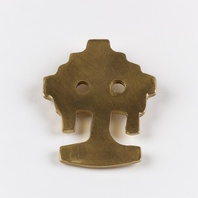
Viking Objects
Reproduction Jewellery Die Stamp
A copper alloy die for creating pressed silver or gold pendants. The original on which this is based had traces of interlace decoration. The presence of finds like this suggests that high-status jewellery production took place in the northern Danelaw.
Read More
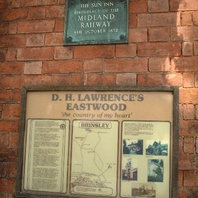
Viking Names
Eastwood
Eastwood, in the Broxtow Wapentake of Nottinghamshire, is a hybrid name formed from Old English east ‘east’ and Old Norse þveit ‘a clearing, a meadow, a paddock’. No form of the name has been found going back to Old Norse austr ‘east’.
Read More
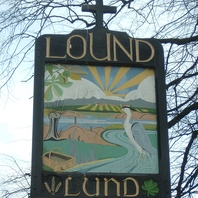
Viking Names
Lound
Lound, in the Bassetlaw Wapentake of Nottinghamshire, comes from the Old Norse element lundr ‘grove, wood’. This origin is celebrated on the village sign, and there is also a Grove Farm in the village.
Read More
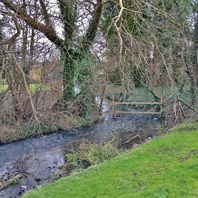
Viking Names
Nether Langwith
Nether Langwith, in the Bassetlaw Wapentake of Nottinghamshire, comes from Old Norse langr ‘long, tall’ and Old Norse vað ‘a ford’. The affix Nether ‘lower downstream’ distinguishes Nether Langwith from Upper Langwith, Derbyshire, further up the river Poulter.
Read More
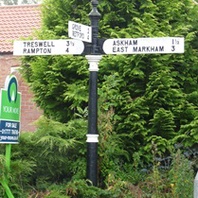
Viking Names
Askham
Askham, in the Bassetlaw Wapentake of Nottinghamshire, probably goes back to an original Old English æschām ‘ash tree farm,’ but the Old Norse cognate askr was substituted at an early date.
Read More

Viking Names
Car Colston
The first element of Colston, in the Bingham Wapentake of Nottinghamshire, is probably the Old Norse male personal name Kolr combined with the Old English element tun ‘an enclosure; a farmstead; a village; an estate’. Thus it is an Anglo-Scandinavian hybrid name. The later prefix Car was added to distinguish this from Colston Bassett. Early spellings suggest that this developed from Old Norse kirkja, ‘church’, in its Middle English form kirk(e). Later this was undoubtedly confused with the word carr (Middle English ker), ‘marshland’, common in Nottinghamshire place-names.
Read More

Viking Names
Perlethorpe
Perlethorpe, in the Bassetlaw Wapentake of Nottinghamshire, was originally a simplex name from the Old Norse element þorp ‘outlying farm, settlement’. The first element derives from the family name Peverel and was added at a later date possibly because the estate became associated with this family. Perlethorpe is a joint parish with Budby.
Read More
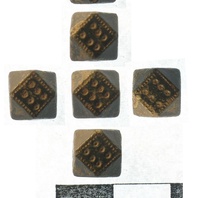
Viking Objects
Polyhedral Weight (SWYOR-3C5372)
This copper-alloy weight is of a type common within the Scandinavian diaspora. This example has fourteen sides and six dots on each of the rectangular sides. These weights were adopted by the Vikings from Middle Eastern examples and appear to have become a de facto weight standard for traders. Weights are an important form of evidence for Viking Age commerce and the use of standards across the different economic systems within which Vikings were integrated. Many of the weights discovered, particularly ones in Ireland and those of Arabic type, suggest that a standardized system of weights existed in some areas. These standard weights, alongside standard values of silver, are what allowed the bullion economy of Viking occupied areas to function. A bullion economy was a barter economy that relied on the exchange of set amounts of precious metal in various forms, such as arm-rings or coins, for tradable goods, such as food or textiles. Each merchant would have brought their own set of weights and scales to a transaction to make sure that the trade was conducted fairly.
Read More
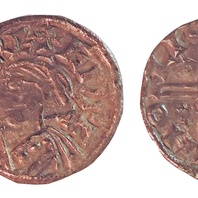
Viking Objects
Northumbrian Penny (NLM-0D491E)
This silver penny was minted in the name of King Eanred of Northumbria. The obverse shows a possibly helmeted and cuirassed individual and reads +EANRE AD RE; the initial cross doubles as X. The reverse reads +CO/ER/[?I]/HO/LI. This particular example was likely brought to Nottinghamshire from Northumbria by means of the Great Army’s overwintering activities in and around Nottingham.
Read More
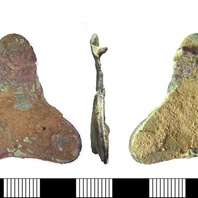
Item
Trefoil Brooch (LEIC-BD8163)
Trefoil brooches were characteristically Scandinavian women’s wear. However, many examples found in the East Midlands were probably made in the Danelaw, and may have been copies of Scandinavian styles, instead of being imported from Scandinavia. The decoration on this example features a foliate design. For more information on Scandinavian jewellery in England check out our blog: Brooches, Pendants and Pins: Scandinavian Dress Accessories in England.
Read More
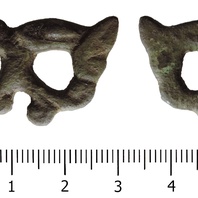
Viking Objects
Zoomorphic Mount (DENO-7E523C)
This example of a copper-alloy openwork zoomorphic mount, strap fitting or harness fitting, is decorated with the head of an animal in profile.
